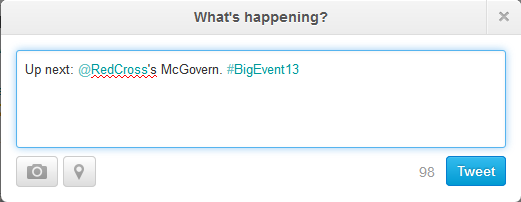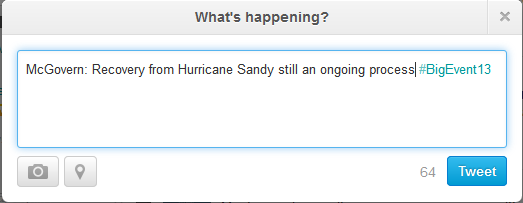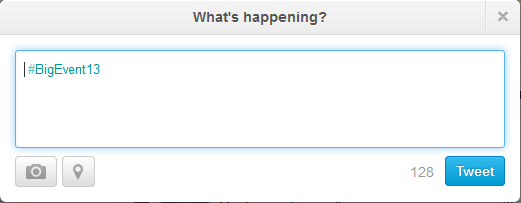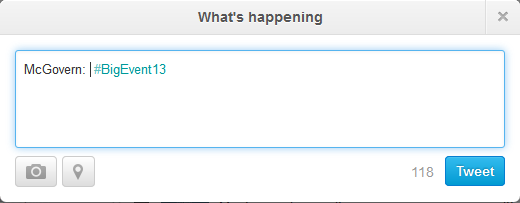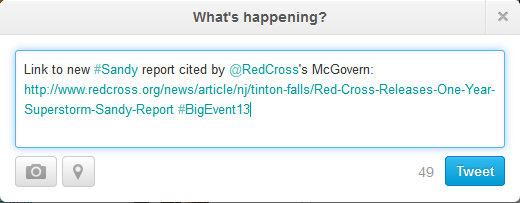Guest article! This piece comes from Abe Greenhouse and is adapted from An Activist’s Guide to Live Tweeting, originally published on Middle East news and analysis site Electronic Intifada. Lots of great advice below — don’t miss it. Also check out an earlier (but much less detailed) guide to live-tweeting we published a couple of years ago.
How to Live-Tweet and Influence People — or Politics
With the continued growth of Twitter, more individuals and organizations have begun leveraging this ubiquitous “microblogging” platform to draw attention to unfolding events as they happen.I can state from personal experience the same thing that Twitter says based on studying vast amounts of data: “Live tweeting” consistently increases retweets, mentions, and new followers. In fact, I’ve observed it to be the single most effective tactic for rapidly attracting new followers.
Here’s how Twitter’s official live tweeting “best practices” page defines it:
Live-tweet (v.): to engage on Twitter for a continuous period of time — anywhere from 20 minutes to a few hours — with a sequence of focused Tweets.
While the general public is mainly inclined to live tweet television programs (don’t get me started), the practice is increasingly being applied at conferences, debates, legal proceedings and all manner of other events at which potentially compelling tweet content is continually generated.
With the idea catching on across a multitude of sectors, articles offering specialized tips for the live tweeting have begun appearing for journalists, public relations firms, nonprofits, search engine optimization (SEO) experts, sports fans and even lawyers. Rather than rehash a large amount of material that can easily be found elsewhere, I’ll quickly outline the core principles, then move on to some more practical tips less likely to be found anywhere else.
Live tweeting: The basics
Know what to share
Train yourself to run through a quick set of questions as you observe the event you’re tweeting: Is the information unique or important? Are you sure it isn’t obvious or redundant? Will it be interesting to anyone outside of the event? Can it enhance the experience of anyone at the event? What do you expect your followers (or those following the hashtag) to find appealing about it? Can you readily express it in a single tweet?
Speed is critical in live tweeting. By cutting down on superfluous content, you’ll be less likely to miss opportunities, and leave yourself with more time to convey the important things in the most compelling way possible.
Note: If you’re not sure whether something should be tweeted, don’t tweet it. Anything you tweet has the potential to be instantly indexed somewhere (and thanks to Edward Snowden, we now know that it will be), even if you delete it thirty seconds later.
Context is king
It’s tempting to act as a social stenographer, but that’s not what you’re there for. Verbatim quotes can be great, but don’t get so hung up on them that you end up providing isolated sound bytes that may be misinterpreted. If you can’t express it in a single tweet, don’t tweet it.
Some try to work around this by appending a “#pt” (previous tweet) hashtag to a followup tweet that adds context. This sounds great in theory, but the fact is that most of the users who see one of those tweets will never see the other.
Attribute everything
Anything you tweet that isn’t purely your own commentary should be properly attributed. If the person you’re quoting is on Twitter, use their @ handle. Try searching both Twitter itself and Google to identify them, and be certain you’re citing the correct user. If the person is not on Twitter, but is affiliated with an organization that does have an account, you many consider using something like
“@RedCross’s McGovern,” bearing in mind that this may suggest that the person is actively speaking on behalf of the organization, and that this will also consume valuable extra characters.
This is one place where it’s okay to bend the “single tweet” rule, but only because affiliation is not absolutely essential to attribution. As such, your first tweet could be:
While tweets containing actual quotes or paraphrasing could shorten the attribution:
Now, on to the less general stuff:
Be prepared
Tweeting requires an electronic device, whether it’s a phone, tablet, or laptop. Electronic devices require power, whether it’s an AC outlet or a battery. I usually come prepared with at least two devices, one of which is a netbook into which I can plug another device to charge via USB if I decide to most of my tweeting on the other device. Close all unnecessary applications on your devices and dim your displays to speed performance and increase battery life.
If you’re planning to tweet an indoor event and want to play it safe, see if the event organizers will help ensure you can sit near a working outlet. They may also be willing to share a wifi access code being distributed on a need-to-know basis to reduce bandwidth consumption.
Also regarding connectivity: if you’ve got a mobile wifi hotspot of your own, all the better. If you have a smartphone and a good tethering app, you can use that to provide a data connection to your laptop (though this can drain the phone’s battery more quickly).
Using multiple accounts
In some situations, you may want to tweet from multiple accounts. If so, have a strategy in mind for what kind content you’ll tweet from each — dividing it up randomly is okay, but you’ll likely get better engagement by varying your focus or tone across the accounts. Have a different device (or a different browser or tab) dedicated to each account so you’ll be able to switch back and forth easily and reduce the chance you’ll get confused.
In Firefox, you can use a “Private Window” to run additional concurrent sessions in Twitter or HootSuite or whatever you’re using without the need to open a separate browser, which will consume memory and drain your battery more quickly. The equivalent in Chrome is an “Incognito Tab”.
Time is precious
Events can move fast … very fast. The first tweet to express an idea, even if it does so poorly, is often the only one that gets retweeted. Keep your tweets timely: populate as much of your “Compose” window as you can ahead of time. If you’re not sure what’s happening next, this may consist only of the hashtag:
If you expect to be quoting a particular person, prepopulate the attribution as well:
Note that in both cases, I’ve included the extra spaces I’ll need once I populate the rest of the content, and positioned the cursor exactly where I’ll need it when I start typing. The fewer clicks or keystrokes required later, the better.
How to stand out from the crowd
Some events are much more heavily tweeted than others. Here are some ways to be heard through the noise and provide compelling content even while many other people are trying to do the exact same thing:
Make it visual
Go beyond text. Snap a photo, a perhaps even a short video (a Vine, for example) if there’s some visually-interesting action going on. Subjects may include speakers, crowd shots (the usual caveats about consent apply), presentation slides or anything else that’s better expressed in images than in words. If you’re particularly deft, or find some extra time during a break, you could even enhance your image with an app like PopAGraph to make it stand out even more.
Collaborate and listen
Did someone else already tweet the same basic thing you’d planned to share, except without attribution, context, or expressed in unclear language? It’s okay to try to improve on it, but don’t make a habit of this. Some of your fellow tweeters may interpret it as “poaching,” or even feel insulted that you seem to think you can do better. Be careful, don’t overdo it, and if it feels appropriate, offer a “hat tip” mention (“h/t”) to the original source.
If you can’t beat ‘em, annotate ‘em
At some events, there will be so many people tweeting, or some people doing such a good job of tweeting, that you may feel you have nothing more to contribute. Wrong. If other tweeters are churning out great quotes, try to provide additional value by linking to relevant resources online:
Annotation is one way to build on great content, but it’s not the only way: if you feel comfortable doing so, add some commentary. Provide some analysis. Offer a new metaphor. Make connections. Crack a joke. Have fun with it.
The man who wasn’t there
Whoever said “You had to be there” got it wrong. Increasingly, you don’t have to be there. As more events are livestreamed, it’s becoming possible to do nearly all of this from your own living room, a cafe, or even another event you’ve decided to attend in person. I’ve tweeted many events without actually being there: sometimes I rely on a livestream; other times I’m just expanding, commenting, or annotating. In many cases, friends following my tweets — even friends actually at the event — have been shocked to learn that I was nowhere near the place when I was tweeting.
Twitter jail
Although speed is essential in live tweeting, it can also cost you if you’re not careful. To reduce the load on its servers, as well as to cut down on spam, Twitter enforces a limit of 1000 tweets per day, and smaller limits for semi-hourly intervals. Although Twitter’s official documentation doesn’t cite a specific an hourly limit, this is generally understood to be 100 tweets. Should these limits be exceeded, Twitter may suspend your account’s ability to post new tweets for ten minutes (for
exceeding the hourly limit) or four hours (for exceeding the daily limit). This type of suspension is commonly known as “Twitter Jail”.
Be mindful of the number of tweets you’re generating, and avoid being jailed if you can. If you’ve got a secondary account available, you can continue tweeting on that one until the primary account is
released, and even respond to tweets mentioning the primary account via the secondary one.
Hashtivism
It’s a not a word yet, but it should be.
Not only do you not have to be there, you don’t even have to be on their side.
In one famous example of a hashtag gone awry, Republicans paid $120,000 to promote the #areyoubetteroff as a sponsored trend, causing it to appear in trending topics lists during the Democratic National Convention without meeting the popularity thresholds that normally apply. The hashtag, intended to elicit negative responses that would challenge the accomplishments of Barack Obama, ended up backfiring as the overwhelming majority of responses included the word “Yes”. This phenomenon was undoubtedly helped along by Democratic Party activists who saw an opening and jumped on the opportunity to fan the flames.
I'd like to see #ROMNEY's and #RYAN's assets from 2008, compare them to today, and ask them #AreYouBetterOff ??
— The Ed (@edeverlasting) September 4, 2012
Activists have also utilized hashtags created by Starbucks to criticize the company’s labor practices, by Vodafone to call attention to the firm’s alleged tax avoidance, and by SodaStream to note that the company’s principal manufacturing facility is located on an Israeli settlement in the occupied West Bank.
All of the techniques described in the earlier sections of this guide can potentially be applied to someone else’s hashtag: Statements by a company’s CEO can be contextualized with commentary on their firm’s practices. Remarks by a candidate can be annotated with links to information that belies them. A tweet that originally included an image reinforcing the point of its source can be repurposed to include an image that undermines it.
Hashtivism also provides a fantastic opportunity to roll out parody accounts like these:
Now that we're not going to file these petitions, can I shoot them? I love shooting documents.
— Ron Gould parody (@NOTRonGould) September 10, 2013
On Twitter, part of the message is always the messenger, and tweets may be interpreted very differently depending on whether they come from an organizational account, a low-profile personal account, or a satirical account specifically designed to resemble that of someone or something else.
Be mindful that users may complain to Twitter that you’re spamming their hashtag by tweeting “multiple unrelated updates” to it, which could theoretically result in a penalty (usually a very brief suspension) from Twitter. However, this is rare, and also depends upon the interpretation of “unrelated.” Keep it relevant in one way or another, and you’re probably in the clear. This won’t protect you from landing in “Twitter jail” for posting too frequently, however.
In conclusion
Whether sharing the experience of an event for your own audience or acting as a disruptive force among someone else’s audience, those who engage in live tweeting have an arsenal of potential tools and techniques at their disposal. They can broadcast an event to Twitter users across the globe, enhance the experience of others actually present, contribute to a crowdsourced transcript that preserves the event for posterity, derail the online engagement initiative of an opponent, or introduce audiences anywhere to challenging new ideas.
Just don’t use what you’ve learned here to tweet American Idol, or I’ll have to block you.

